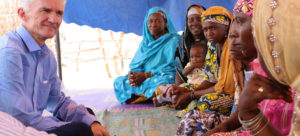Dawes notes on pages 8-9 that, “…giving voice can also be a matter of taking voice.” And “This contradiction between our impulse to heed trauma’s cry for representation and our instinct to protect it from representation –from invasive staring, simplification, dissection – is a split at the heart of human rights advocacy.” Indeed. How does Dawes appear to address this dilemma in the book? What are your thoughts about how to address this issue? Who has a right to tell the stories of human suffering? Who has the responsibility to tell the stories of human suffering?
One hard part about showing visuals or telling stories about others who’ve experienced an atrocity is trying to understand what gives someone the right to tell those stories in the first place. You can see how someone who was not directly impacted could be seen as unqualified, especially if they had no first-person account, but even those who experienced firsthand, don’t all share the same experiences. In “That the World May Know: Bearing Witness to Atrocity” by James Dawes, the author highlights that a humanitarian has the option to leave whereas the affected community is forced to live amidst constant turmoil. Their experiences are inevitably different, especially in circumstances where those individuals are the direct target.
On the other hand, a response to a crisis is largely triggered by the exposure it gets. Dawes mentions the idea that stories and visuals can inspire outsiders to act by donating or even putting pressure on their governments. Individuals with an international audience can be more beneficial in conveying the stories of the affected people in these cases. Yet, history shows people can be exposed and still not act. We actually may get stories and images that define the narrative and diminish the atrocity to something that is disengaged from the audience and, therefore, becomes more of a story than a historical account.
On the other hand, a response to a crisis is largely triggered by the exposure it gets. Dawes mentions the idea that stories and visuals can inspire outsiders to act by donating or even putting pressure on their governments. Individuals with an international audience can be more beneficial in conveying the stories of the affected people in these cases. Yet, history shows people can be exposed and still not act. We actually may get stories and images that define the narrative and diminish the atrocity to something that is disengaged from the audience and, therefore, becomes more of a story than a historical account.
“In giving voice to suffering we can sometimes moderate it, even aestheticize it (Dawes, 8).”
Not only do certain visuals and stories desensitize the audience if consistently promoted, but the affected people may not necessarily want themselves portrayed in the ways they often are. I’m conflicted because people need to see and hear about these things in order to believe or empathize with those they effect, but I don’t feel outsiders are always the right choice to tell stories they didn’t experience. The outside involvement can often give a wider scope to a problem, provide supplemental information like documented history or context and facts, but if the story is meant to be emotive, they are also tasked with conveying the emotional and psychological toll of the affected people. Honestly, I don’t believe they’re qualified to do so independently. I would say the answer is for the story tellers to speak with people affected in order to get the most accurate account and/or their input on their portrayal, but with language barriers and personal/hidden agendas, it’s still not always possible.
In regards to whose responsibility it is to tell these stories, I want to say the responsibility falls of whomever has the ability get the information out there, but I feel that sentiment maybe irresponsible. It is said that we teach history to aid against repeating it, but there is also the stigma that history is written by the victors. That makes me a little gun-shy about those outside of the affected community speaking on behalf of, or to tell a story about, things they didn’t experience personally. When it comes to human suffering, in particular, I feel like we need a communicator that can get the information to everyone in the world especially when a call-to-action is needed, but the insights, perceptions, feelings and realities for those affected needs to be realized and communicated as well. I do think humanity is entitled to the unmitigated truth, no matter how cruel or uncomfortable it may be. The next barrier will be figuring out what crosses the line into poverty porn or capitalizing on human suffering.

